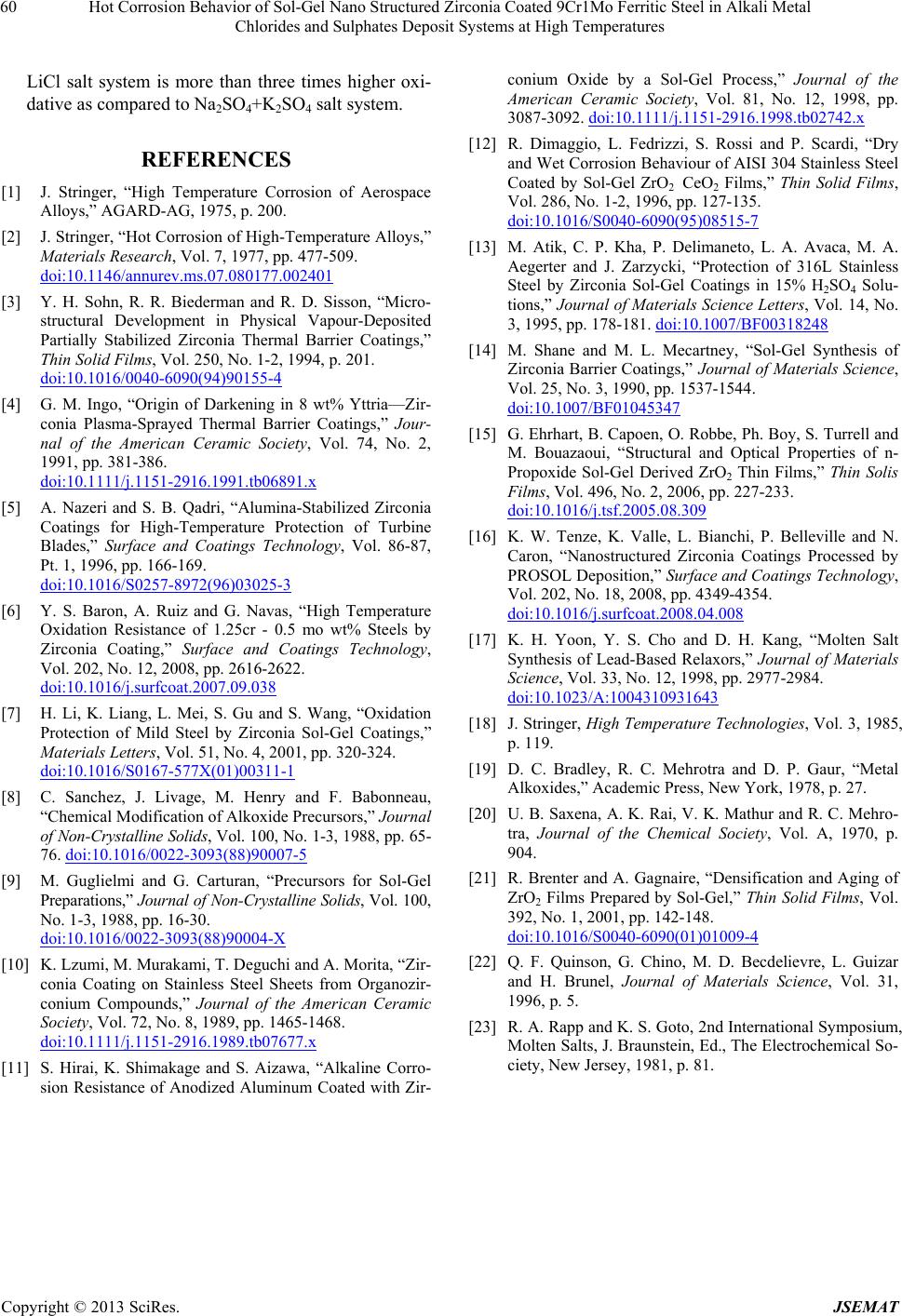
Hot Corrosion Behavior of Sol-Gel Nano Structured Zirconia Coated 9Cr1Mo Ferritic Steel in Alkali Metal
Chlorides and Sulphates Deposit Systems at High Temperatures
Copyright © 2013 SciRes. JSEMAT
60
LiCl salt system is more than three times higher oxi-
dative as compared to Na2SO4+K2SO4 salt system.
REFERENCES
[1] J. Stringer, “High Temperature Corrosion of Aerospace
Alloys,” AGARD-AG, 1975, p. 200.
[2] J. Stringer, “Hot Corrosion of High-Temperature Alloys,”
Materials Research, Vol. 7, 1977, pp. 477-509.
doi:10.1146/annurev.ms.07.080177.002401
[3] Y. H. Sohn, R. R. Biederman and R. D. Sisson, “Micro-
structural Development in Physical Vapour-Deposited
Partially Stabilized Zirconia Thermal Barrier Coatings,”
Thin Solid Films, Vol. 250, No. 1-2, 1994, p. 201.
doi:10.1016/0040-6090(94)90155-4
[4] G. M. Ingo, “Origin of Darkening in 8 wt% Yttria—Zir-
conia Plasma-Sprayed Thermal Barrier Coatings,” Jour-
nal of the American Ceramic Society, Vol. 74, No. 2,
1991, pp. 381-386.
doi:10.1111/j.1151-2916.1991.tb06891.x
[5] A. Nazeri and S. B. Qadri, “Alumina-Stabilized Zirconia
Coatings for High-Temperature Protection of Turbine
Blades,” Surface and Coatings Technology, Vol. 86-87,
Pt. 1, 1996, pp. 166-169.
doi:10.1016/S0257-8972(96)03025-3
[6] Y. S. Baron, A. Ruiz and G. Navas, “High Temperature
Oxidation Resistance of 1.25cr - 0.5 mo wt% Steels by
Zirconia Coating,” Surface and Coatings Technology,
Vol. 202, No. 12, 2008, pp. 2616-2622.
doi:10.1016/j.surfcoat.2007.09.038
[7] H. Li, K. Liang, L. Mei, S. Gu and S. Wang, “Oxidation
Protection of Mild Steel by Zirconia Sol-Gel Coatings,”
Materials Letters, Vol. 51, No. 4, 2001, pp. 320-324.
doi:10.1016/S0167-577X(01)00311-1
[8] C. Sanchez, J. Livage, M. Henry and F. Babonneau,
“Chemical Modification of Alkoxide Precursors,” Journal
of Non-Crystalline Solids, Vol. 100, No. 1-3, 1988, pp. 65-
76. doi:10.1016/0022-3093(88)90007-5
[9] M. Guglielmi and G. Carturan, “Precursors for Sol-Gel
Preparations,” Journal of Non-Crystalline Solids, Vol. 100,
No. 1-3, 1988, pp. 16-30.
doi:10.1016/0022-3093(88)90004-X
[10] K. Lzumi, M. Murakami, T. Deguchi and A. Morita, “Zir-
conia Coating on Stainless Steel Sheets from Organozir-
conium Compounds,” Journal of the American Ceramic
Society, Vol. 72, No. 8, 1989, pp. 1465-1468.
doi:10.1111/j.1151-2916.1989.tb07677.x
[11] S. Hirai, K. Shimakage and S. Aizawa, “Alkaline Corro-
sion Resistance of Anodized Aluminum Coated with Zir-
conium Oxide by a Sol-Gel Process,” Journal of the
American Ceramic Society, Vol. 81, No. 12, 1998, pp.
3087-3092. doi:10.1111/j.1151-2916.1998.tb02742.x
[12] R. Dimaggio, L. Fedrizzi, S. Rossi and P. Scardi, “Dry
and Wet Corrosion Behaviour of AISI 304 Stainless Steel
Coated by Sol-Gel ZrO2 CeO2 Films,” Thin Solid Films,
Vol. 286, No. 1-2, 1996, pp. 127-135.
doi:10.1016/S0040-6090(95)08515-7
[13] M. Atik, C. P. Kha, P. Delimaneto, L. A. Avaca, M. A.
Aegerter and J. Zarzycki, “Protection of 316L Stainless
Steel by Zirconia Sol-Gel Coatings in 15% H2SO4 Solu-
tions,” Journal of Materials Science Letters, Vol. 14, No.
3, 1995, pp. 178-181. doi:10.1007/BF00318248
[14] M. Shane and M. L. Mecartney, “Sol-Gel Synthesis of
Zirconia Barrier Coatings,” Journal of Materials Science,
Vol. 25, No. 3, 1990, pp. 1537-1544.
doi:10.1007/BF01045347
[15] G. Ehrhart, B. Capoen, O. Robbe, Ph. Boy, S. Turrell and
M. Bouazaoui, “Structural and Optical Properties of n-
Propoxide Sol-Gel Derived ZrO2 Thin Films,” Thin Solis
Films, Vol. 496, No. 2, 2006, pp. 227-233.
doi:10.1016/j.tsf.2005.08.309
[16] K. W. Tenze, K. Valle, L. Bianchi, P. Belleville and N.
Caron, “Nanostructured Zirconia Coatings Processed by
PROSOL Deposition,” Surface and Coatings Technology,
Vol. 202, No. 18, 2008, pp. 4349-4354.
doi:10.1016/j.surfcoat.2008.04.008
[17] K. H. Yoon, Y. S. Cho and D. H. Kang, “Molten Salt
Synthesis of Lead-Based Relaxors,” Journal of Materials
Science, Vol. 33, No. 12, 1998, pp. 2977-2984.
doi:10.1023/A:1004310931643
[18] J. Stringer, High Temperature Technologies, Vol. 3, 1985,
p. 119.
[19] D. C. Bradley, R. C. Mehrotra and D. P. Gaur, “Metal
Alkoxides,” Academic Press, New York, 1978, p. 27.
[20] U. B. Saxena, A. K. Rai, V. K. Mathur and R. C. Mehro-
tra, Journal of the Chemical Society, Vol. A, 1970, p.
904.
[21] R. Brenter and A. Gagnaire, “Densification and Aging of
ZrO2 Films Prepared by Sol-Gel,” Thin Solid Films, Vol.
392, No. 1, 2001, pp. 142-148.
doi:10.1016/S0040-6090(01)01009-4
[22] Q. F. Quinson, G. Chino, M. D. Becdelievre, L. Guizar
and H. Brunel, Journal of Materials Science, Vol. 31,
1996, p. 5.
[23] R. A. Rapp and K. S. Goto, 2nd International Symposium,
Molten Salts, J. Braunstein, Ed., The Electrochemical So-
ciety, New Jersey, 1981, p. 81.